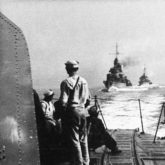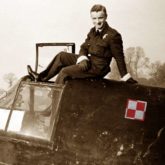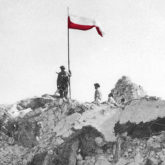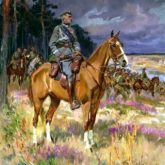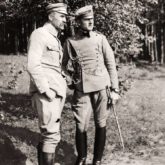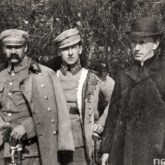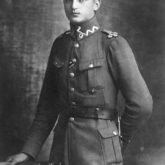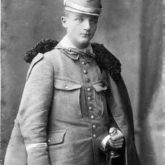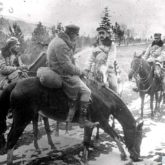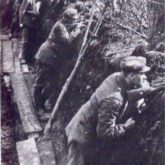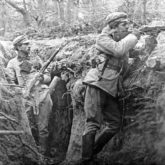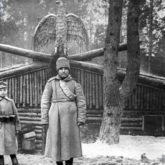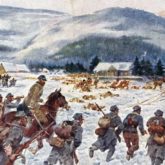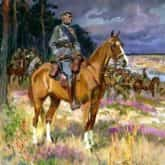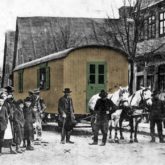„Szara piechota” (Grey Infantry) – a Polish military song associated with Polish units fighting
against Russia as part of the Austro-Hungarian army during the First World War. The melody and
lyrics were probably written by Leon Łuskino and Bolesław Lubicz – Zahorski. In the inter-war
period, the song gained enormous popularity in Poland. The „Grey Infantry” mentioned in the title
are the soldiers of the Polish units that were formed after the outbreak of the First World War in the Polish lands seized by Austria in the 18th century. In 1915, they already formed 3 brigades (about 17,000 men). They were commonly referred to as the „Piłsudski Legions”, after the organiser and commander of the First Brigade, the Polish independence activist Józef Piłsudski. The legend of the Legionnaires’ struggle later became one of the ideological foundations of the reborn Poland.
Grey Infantry
Music: Leon Łuskino
Lyrics: Bolesław Lubicz-Zahorski and Leon Łuskino
Song description
Title: Grey Infantry
Music: Leon Łuskino
Lyrics: Bolesław Lubicz-Zahorski and Leon Łuskino
Historical note
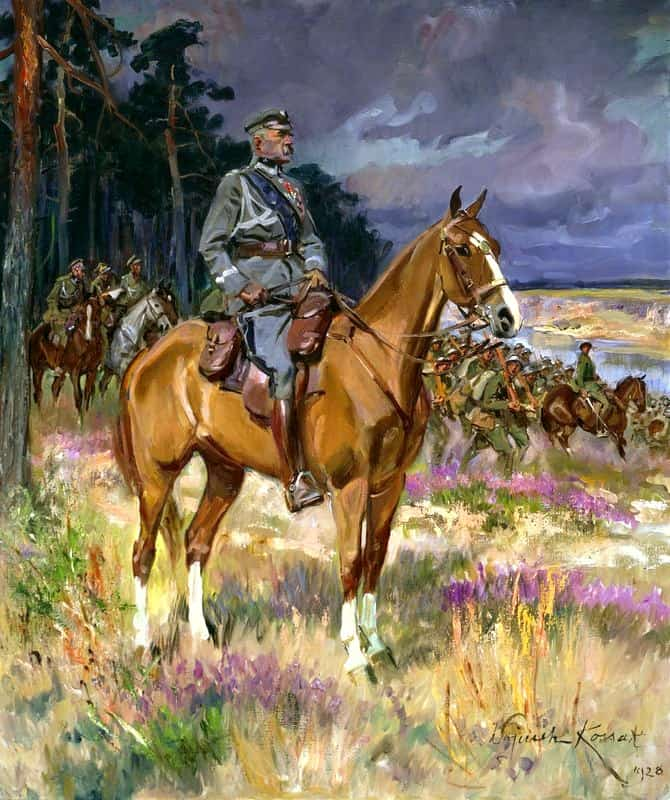
We do not know when exactly the song known as “Szara piechota” (Grey Infantry) or „Maszerują strzelcy” (Riflemen Are Marching) was written. Most studies point to the year 1918, although it could also have been created at the turn of 1915 and 1916. Historians are also in doubt regarding the authorship of the melody and text. Some studies on the subject give Lieutenant-Colonel Leon Łuskino as the main author (e.g. Wacław Panek, „Hymny polskie”, Warsaw, Wydawnictwa Szkolne i Pedagogiczne, 1997.), who is supposed to have written this song to the melody of an earlier song „Ułani ułani” („Uhlans, Uhlans) by Bolesław Lubicz – Zahorski. Other sources suggest Łuskino as the author of the music, while Lubicz -Zahorski as the author of the text.
Originally, the song began with the words „Nie nosim wyłogów i szary nasz strój” („We don’t wear the stripes and grey is our outfit”), which referred to the cut and colour of legionary infantry uniforms. This beginning was later replaced by the words „They wear no lampposts, but their garb is grey”. „Grey Infantry” was published for the first time as late as 1929. It was also repeatedly published in many songbooks in the 1930s. Five variants of the text are known, the last of which is a partisan song from the Second World War. The basic version is a description of the march of a legionary infantry, emphasising the pride of its soldiers in fighting for the freedom of a reborn Poland and their courage and contempt of death. This text is often sung with one mistake – in the second stanza, the words „And before them the spars salute” are sometimes replaced by „And before them the trees salute”. Not the trees, but the spars of the legion banners. It is also incorrect to describe, in various interpretations, the grey of the uniforms which is mentioned in the song as „a symbol of modesty, sacrifice and bravery”. It was simply a regulation colour, having nothing to do with any higher ideals.
History of the Polish Legions
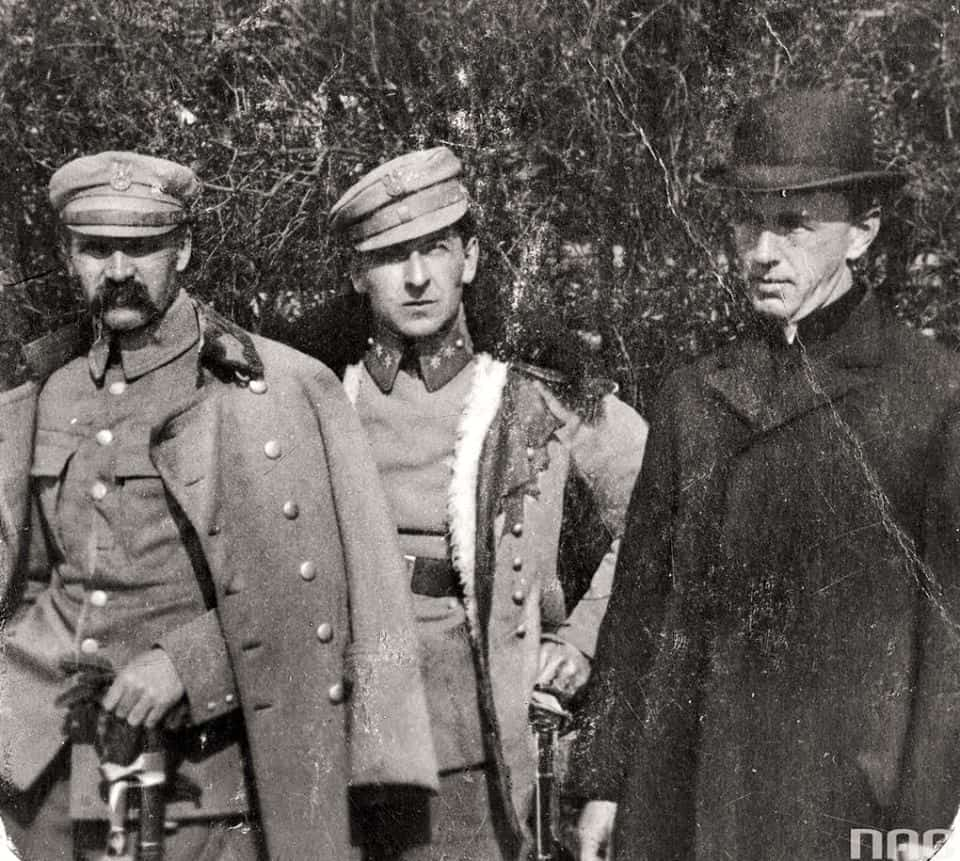
The Polish Legions, for which this song was written, were a Polish formation within the Austro-Hungarian army’s ordre de bataille. Their history began with the formation of the First Cadre Company (Pierwsza Kompania Kadrowa), which was formed by Józef Piłsudski in Kraków on 3 August 1914, by combining units of the Riflemen’s Association ( Związek Strzelecki) and the Polish Riflemen’s Squads (Polskie Drużyny Strzeleckie). Officially, the Legions were formed on 27 August, when the Austrian command issued an order establishing the Eastern Legion (in Lwów) and the Western Legion (in Kraków). In view of the occupation of Lvov by the Russian army, the Eastern Legion was disbanded already in September. The Western Legion fielded the 1st Infantry Regiment, which, under Józef Piłsudski’s command, fought as a rearguard to the Austrian army on the left bank of the Vistula, and later – during the counter-offensive at the turn of October and November – took part in the battles of Laski, Anielin and Krzywopłoty. Formed in September 1914, Regiments 2 and 3 were transferred to the Carpathian Mountains and fought there in October, including at Molotokovo, Zielona, Rafajłowa and Kirlibaba.
At the end of November, the 1st Regiment, threatened by encirclement by the Russian army, broke through in a desperate attack (the Ulina Mala manoeuvre) to Kraków. After a short break and replenishment of the losses, the regiment fought at Mszana Dolna, Limanowa, Marcinkowice and Nowy Sącz. In mid-December 1914, the unit was officially developed into the First Brigade of the Polish Legions. The year 1914 ended with the Legionnaires’ participation in the Battle of Łowczówek. After a winter break, the First Brigade fought on the Nida River, and then took part in a summer offensive, fighting fierce battles in the Świętokrzyskie region. After crossing the Vistula, it moved on to the Lublin region, and later to Podlasie. In May 1915, the units previously fighting in the Carpathian Mountains were merged into the Second Brigade of the Polish Legions. Its command was entrusted to Austrian General Ferdinand Küttner. This brigade took part in battles in the Bukovina (the famous charge at Rokitna) and on the Prut River. On 8 May 1915, the 3rd Brigade of the Polish Legions was formed from the 4th and 6th Infantry Regiments under the command of Colonel Wiktor Grzesicki.
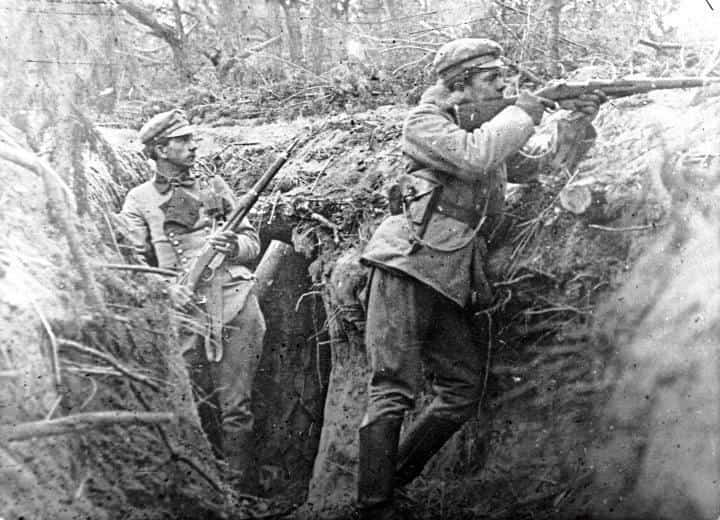
All three brigades put together numbered around 17,000 officers and soldiers. In the autumn of 1915, they were redeployed to Volhynia, where they took part in battles on the Styr River. Winter brought no rest this time. The Legions remained in their positions for several months, gradually losing soldiers in constant clashes. When the Russian Brusilov Offensive was launched in June 1916, all three brigades, deprived of artillery and communications with higher command, had only about one-third of their full strength. Despite this, between 4 and 6 July, the Poles, fighting a numerically vastly superior enemy, held their positions at Kostiuchnówka, which was of strategic importance for the entire front. Unfortunately, the losses of the Polish brigades in this bloody battle amounted to almost 40% of their initial forces. On 20 September 1916, the Legions were reformed into the Polish Auxiliary Corps (Polski Korpus Posiłkowy). Following the proclamation of the Kingdom of Poland (Act of 5 November 1916), Austria-Hungary handed over command of the Polish Corps to the German Governor of Warsaw, General Hans von Beseler. Attempts to limit the Legions’ autonomy led to so-called „oath crisis” in August 1917. Most Legionnaires rejected the new oath rote, which included a declaration of allegiance to the German Kaiser. Only Colonel Józef Haller’s Second Brigade accepted it. It remained the only force of the Corps composed of: 2nd and 3rd Infantry Regiments, 2nd Lancers Regiment and 1st Light Artillery Regiment. „The Oath Crisis” was de facto the end of the history of the Polish Legions. The PKP was still fighting in Bukovina. On 16 February 1918, the 2nd Brigade, in protest against the conclusion of the Peace of Brest, broke the front and crossed over to the Russian side at Rarańcza, joining the 2nd Polish Corps in Russia. This was the last armed action of a formation of Legionary origin.
„Grey Infantry” was included for the first time in the „Polish Soldier’s Songbook” („Wojskowy śpiewnik żołnierza polskiego”, which was published in 1929. During World War II, the melody of „Grey Infantry” was used as a basis for many new partisan, soldier, insurgent and prisoner of war songs.
Compiled by Piotr Pacak
 Strona dostępna w języku polskim
Strona dostępna w języku polskim  Website disponível em português
Website disponível em português 